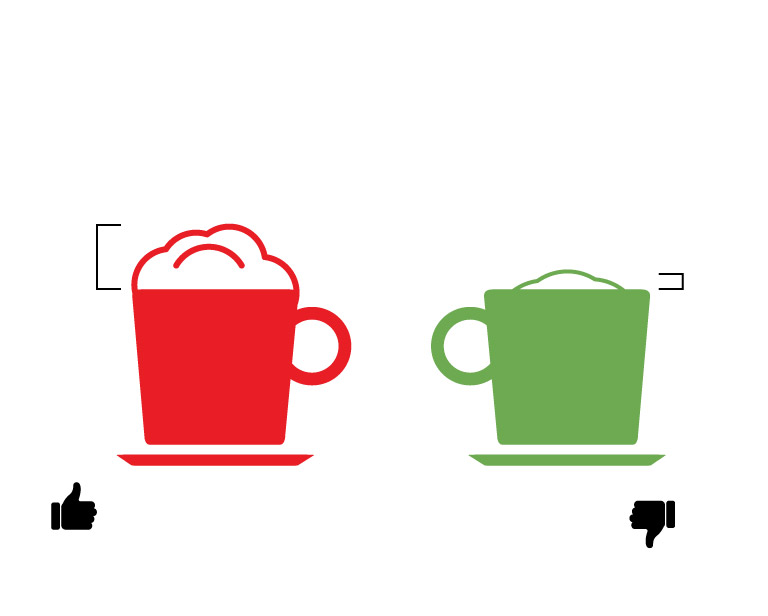
Dairy vs. plant milk: Which is better?
Team Dairy and Team Plant have hit the court to compete across several categories for best overall milk beverage
Do you prefer your milk from a cow or from a plant?
Across the globe, cow’s milk wins, but in recent years more people have embraced plant-based milks made from almonds, oats and soy.
We pitted dairy milk against plant milk to see how the beverages compare in various categories, including nutrition, cost, environmental impact and even how well they make frothy coffee.
Pick your team and keep reading to see how the competition plays out.
(TWP)
(TWP)
(TWP)
POSSESSION 1 OF 12
Vitamins and minerals
Cow’s milk has all the nutrients needed to promote the growth of a calf, including calcium, potassium, B-12, riboflavin and phosphorous. And most dairy milk sold in America is fortified with additional vitamins, including D, which milk producers have been adding to cow’s milk since the 1930s to prevent children from developing rickets, a disease that weakens bones.
Vitamins in plant milk vary widely. In one study of 233 plant-based milks, including almond, oat, rice, cashew, flax and soymilk, researchers found 70 percent were fortified with both calcium and vitamin D. Read the label to determine if your favorite plant milk is fortified.
“There’s wide variability of fortification,” said Abigail Johnson, associate director of the University of Minnesota School of Public Health Nutrition Coordinating Center. “Some plant milks look like a multivitamin. And some are not fortified with anything.”
In this round, dairy milk scores an easy layup.
SCROLL TO CONTINUE
POSSESSION 2 OF 12
Fiber
Fiber is good for your gut microbiome, heart and immune system — yet most people aren’t getting nearly enough of it.
You won’t find any fiber in cow’s milk. But you will find modest amounts in several plant milks. Some oat milk brands contain 2 or 3 grams of fiber per serving. Soy, almond and some other plant milks have smaller amounts.
Since every little bit of fiber will help you reach your daily needs, this category is an easy slam dunk for plant milk.
SCROLL TO CONTINUE
POSSESSION 3 OF 12
Protein
Got protein? Dairy milk certainly does. One cup of whole or low-fat milk contains 8 grams of protein, making it a rich source of this muscle-building nutrient. Ultra-filtered milk, such as Fairlife, has a whopping 13 grams of protein per cup. It’s made by filtering some of the water and lactose out of regular milk, creating a higher concentration of protein.
The amount of protein in plant milks varies, but researchers have found that plant milks were generally lower in protein than dairy milk. Pea milk – sometimes called “plant protein milk” – had 7.5 grams of protein per cup, the most for any plant milk. Soy milk had an average of 6.1 grams of protein per cup, while almond milk had 1 gram.
If protein is what you’re looking for, then you can count on dairy milk for a nice assist.
SCROLL TO CONTINUE
POSSESSION 4 OF 12
Bone health
Calcium is needed for healthy bones, but studies have found that significantly increasing dairy and calcium intake had no impact on children’s bone mineral density.
If you eat a healthy and varied diet, you’re probably getting calcium from many different foods, not just milk. Calcium also can be found in fortified plant and soy milks, as well beans, vegetables, whole grains, fish, nuts, seeds and tofu, notes Walter Willett, a professor of epidemiology and nutrition at the Harvard T.H. Chan School of Public Health.
In this matchup, no team scores, so we’ve got a tie.
SCROLL TO CONTINUE
POSSESSION 5 OF 12
Fat and cholesterol
Most plant milks contain little or no saturated fat – the kind of fat that raises your LDL cholesterol, which is linked to heart disease. (An exception is coconut milk, which is high in saturated fat.) Plant milks typically contain mostly unsaturated fat, which is the heart-healthy kind that can actually improve your blood cholesterol levels.
Fat content in dairy milk ranges from as little as 0.2 grams of fat in one cup of nonfat milk to around 8 grams of fat in whole milk. Most of the fat in dairy is the saturated kind. A cup of 1 percent milk contains about 1.4 grams of saturated fat, compared to around 4.5 grams in whole milk.
Plants are naturally free of dietary cholesterol, so you won’t find any cholesterol in plant milks, although you will find it in cow’s milk.
In this round, plant milk scores an easy layup.
SCROLL TO CONTINUE
POSSESSION 6 OF 12
Heart disease
In large studies, scientists have found no clear association between whole or low-fat dairy milk consumption and heart disease or mortality. But fermented dairy products like kefir and yogurt may be protective against cardiovascular disease.
And randomized trials show that when people cut back on foods high in saturated fat and replace them with foods high in polyunsaturated fat – like nuts, fish, vegetable oils and plant milks – their risk for heart attack declines.
“Replacing dairy fats with plant fats reduces cardiovascular disease rates strongly,” said Willett.
On this matter, plant milks are the clear favorite. Put another point on the board for plant milks.
SCROLL TO CONTINUE
POSSESSION 7 OF 12
Froth
For many coffee lovers, a latte or cappuccino wouldn’t be complete without silky-smooth milk that’s been steamed to perfection. But not every milk turns frothy and foamy when steamed.
Whole dairy milk has precisely the right amount of fat and protein to make steamed milk with velvety foam, said Giorgio Milos, the 2008 barista champion of Italy and “master barista” for Illycaffe North America. The fat in whole milk also helps to highlight the aromas of high-quality coffee.
“The more lipids you can get in the milk, the more coffee flavor you can extract,” said Milos. Whole milk is, “in the opinion of the whole coffee community, considered the best milk you can use for coffee.”
Almond, oat, soy and other plant milks generally do not hold up well when steamed because they’re relatively thin, said Milos. “It’s like trying to steam water – you don’t get any foam,” he said. Plant milks can have distinct tastes that overshadow the flavors of your coffee. Oat milk tends to have a more neutral flavor.
Some plant milks now come in “barista” blends that contain emulsifiers and other additives so they can turn frothy when steamed.
For frothy coffee, it’s hard to beat whole milk. Another point for dairy.
SCROLL TO CONTINUE
POSSESSION 8 OF 12
Environmental impact
The livestock sector is a major emitter of methane. Last year, a study by researchers at Johns Hopkins found that greenhouse gas emissions created by soy, oat, almond, spelt, pea and coconut milk production were 62 to 78 percent lower on a median per-liter basis compared to the emissions associated with cow’s milk.
“With cow’s milk the greenhouse gas emissions are a lot higher than every plant-based milk,” said Becky Ramsing, a senior program officer at the Johns Hopkins Center for a Livable Future.
But dairy farmers are using contraptions called “methane digesters” to help reduce carbon emissions. They’re also using special feeds to lower the amount of methane that dairy cows produce. Alan Bjerga, a spokesman for the National Milk Producers Federation, said the industry has pledged to achieve net zero carbon emissions by 2050.
Plant milks also have an environmental footprint. Almond production is typically water-intensive, which can be especially detrimental in water-scarce areas. A 2019 study found that California almonds had an average water footprint of about 3.2 gallons per almond.
While most plant-milk production uses less water than dairy, the studies on almond milk are mixed. A 2022 study compared the environmental impact of cow’s milk and several popular plant milks on 12 metrics, such as land use, ecosystem damage, greenhouse gas emissions and water use. They found that plant milks had a lower overall impact than cow’s milk, and that oat and soy milks were the most environmentally friendly.
Plant milks in this case are the clear all-star.
SCROLL TO CONTINUE
POSSESSION 9 OF 12
Animal welfare
Videos of dairy cows being beaten or confined to small, unsanitary enclosures on factory farms have contributed to public concerns about the dairy industry. Newborn calves are separated from their mothers and become replacements for the milking herd or get turned into veal or other food. When an old cow stops producing milk, “she is cycled into low-fat hamburger – because a cow is usually very lean and emaciated by that time,” said Willett.
Bjerga of the National Milk Producers Federation said that the dairy industry is addressing concerns about animal welfare through a voluntary National Dairy FARM Program that establishes animal welfare management guidelines and standards.
Bjerga acknowledged there have been “bad actors” in the industry, but said that the FARM program has mechanisms in place to deal with farms that violate its standards.
Almond milk has faced scrutiny too. The almond industry depends on bees for pollination. But almonds and other crops are often treated with insecticides that can harm birds, bees and other animals.
In this category, plant milk comes out on top.
SCROLL TO CONTINUE
POSSESSION 10 OF 12
Cost
One place where cow’s milk has less of an impact is your wallet. In 2023, researchers at Johns Hopkins analyzed the average retail price of dairy and plant milks compared to their average nutrient value. They found that cow’s milk had a lower unit cost and large amounts of protein, vitamins and minerals. On these metrics, almond and rice milk fared the worst. According to Nielsen data, the unit price of plant milks is about 20 percent higher on average than cow’s milk.
“For families who are struggling to pay for nutritious foods especially with food prices going up, some of these plant milk alternatives are pretty expensive,” said Ramsing at Johns Hopkins.
Moove over plant milk. When it comes to getting the most bang for your buck, dairy milk shoots and scores.
SCROLL TO CONTINUE
POSSESSION 11 OF 12
Allergies and intolerance
About 68 percent of people worldwide – and 36 percent of Americans – have a reduced ability to digest lactose, the naturally occurring sugar in milk. Lactose intolerance is most prevalent among people of Asian, Latin American and African descent. Symptoms include bloating, gas, cramps and diarrhea. Cow’s milk allergy, one of the most common food allergies, occurs when your immune system reacts to the proteins in milk, triggering an allergic reaction with symptoms such as an itchy rash or difficulty breathing.
Peanuts, soy and tree nuts are also common allergens. In one study, scientists found that cow’s milk, almond milk, soy milk and coconut milk all elicited allergic responses in some participants.
For this particular category, the winner depends on individual risk, so we’re calling a jump ball.
SCROLL TO CONTINUE
POSSESSION 12 OF 12
Added sugars
A University of Minnesota analysis of 233 plant-based milks found that 63 percent contained added sugar. And about 1 in 5 plant milks tested contained more than 10 grams of added sugar per serving. That’s about 2½ teaspoons of sugar in each cup.
The highest levels of added sugar were found in some brands of rice, soy, hemp, oat and almond milk.
Regular cow’s milk contains lactose, which doesn’t spike your blood sugar levels or carry the same health risks as other sugars. But avoid flavored milks: A cup of low-fat chocolate milk typically contains around 12 grams of added sugar.
This category is a win for plain dairy milk.
SCROLL TO CHOOSE WHO TAKES THE GAME WINNING SHOT
Game over and our dairy vs. plant milk matchup has ended in a tie. Based on the issues that are most important to you, who should make the game-winning shot?





























